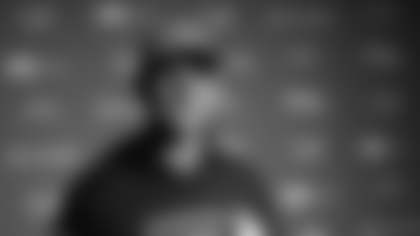**
BB:** We're just grinding away here on the Raiders. Again, a lot to get ready for, a lot of new faces, a lot of things we need to work on in all three phases of the game. Hopefully we can pull our preparations together today, some situational preparation, and be ready to go. I think everybody is excited to come back home and take the field here. Looking forward to the game, looking forward to the opportunity but we're going to have to do a lot of things well and certainly improve in some areas, obviously penalties being one of those over last week. That's kind of where we're at.
Q: Why do you think you guys have been so good at home over the last 10-plus years?
BB: Good players. Yeah, winning games in this league is all about having good players. I've been fortunate to have a lot of them. Players win games.
Q: How do you parse all the stuff a team does offensively, especially if a team only shows something once every once in a while, how do you decide how much time to devote to that?
BB: That's a great question. The reality of it is, not only have they shown a lot of things sometimes just a few times, but we also know there's going to be a couple new things we haven't even seen yet, that they're going to have for us. But I would say the reality of it is, in the running game, it's hard to have like 10 new runs every week. Usually what you have is maybe one new run but sometimes the runs that you have that are your core plays, you try to disguise and run differently, either a different personnel, maybe a different formation, maybe change the look a little bit so that the defense doesn't see the play until right when or after the ball is snapped as opposed to be being able to look at it for five or six seconds and say, 'OK, here comes the lead or here comes the power or here comes the counter,' or whatever. I think that's really more what we need to do defensively is we need to understand the basic concept of the play knowing that they can get to it in a lot of different ways. They can build it formationally, they can build it from different personnel groups but in the end, here are the basic blocking schemes, this is what we have to defeat. Can we guess which way they're going to run it? Probably not. But their basic core plays from different looks, can we recognize those after the snap? I mean hopefully yes, that's the idea. When you go back to Washington's offense, Joe Gibbs was there when I was at the Giants. They really, honestly, they really only had three plays, running plays. That's really all they had. But they had a million different ways to run them – every formation, personnel groups, motion, shifting and it was hard to recognize because it was always different every week. It was a different shift and a different motion from the previous week, so you could never really zero in on that, but the plays were the same. We tried to coach our team to defeat the plays knowing that they would get to them in different ways. We had to make some formation adjustments but the plays were the plays. But really it's unbelievable the amount of success they had running really, running the inside zone, running the outside zone and running the counter OT. And all three plays kind of looked the same. They could pretty much do them all out of the same or very similar looks. They complemented them well. Those were the ones you had to stop. I mean, there might be one or two other things sprinkled in, but that had to be 90 percent of it. They won a lot of games doing that.
Q: How pleased have you been with Cameron Fleming so far? When you drafted him, did you anticipate you'd play him in that jumbo package at tight end?
BB: I think Cam has done a good job for us. One of the real challenges for Cam and for us was just him not really being here for much of the spring. He just came late in the spring because of his commitments at school. We really didn't have a great feel for him until I'd say training camp started. Then when training camp started and he came back in really good condition – he ran well, he dropped some weight, he leaned up, he worked very hard between the beginning of June, the middle of June and the end of July. He was definitely ready to go, had a good camp and performed very well and mentally caught up to all the things that we were doing in a pretty short amount of time. The more time we spent around him, the more impressed we were. But it took a little while because we really didn't get to see him until whenever it was, the second week of June I think. No, I think when you draft a guy, you don't draft a tackle to play tight end, just like we didn't draft [Nate] Solder to play tight end even those his rookie year he played a lot of that same position. Sometimes it just works out that way for one reason or another, depending on your team, maybe also depending a little bit on the player's skills. I think Cam showed us repeatedly, both in practice and preseason games, the practices against Philadelphia and Washington, that he could earn time on the field. Sometimes you sit in there as a staff and say, 'OK, how do we get our best players on the field?' Or, 'How do we get our best blockers on the field?' That's one way to do it in this case. He's done well. It's one guy further away from the ball. There's a lot of different looks that a tight end has to see relative to the outside linebacker, the defensive end, the safety, sometimes the corner on the backside, slot, there are a lot of configurations back there that are a lot different than what a tackle sees. But he's done a good job of that, of identifying those, recognizing them, sorting it out and working in conjunction with either another tight end or the adjacent tackle to the inside of him. He's done well.
Q: What have you liked so far from the rotation of safeties that you've used? How important is Devin McCourty back there in allowing you to do that?
BB: Devin's huge. He's really our most experienced player in terms of on our team in our system. He's played corner, played safety, played some of the other positions too – the nickel, dime positions from time to time, certain matchups. He understands our defense well, he gives us a lot of experience back there, continuity, good communication, smart player, really anticipates, has good awareness, good instincts. He's certainly a good guy for whichever other safety has been in there with him, whether it's Patrick [Chung], Tavon [Wilson], Nate [Ebner], however it's gone back there. He's been a good guy for them to work with.
Q: Safe to say that if you didn't have a guy as experienced as Devin, it would be a lot harder to rotate players in that position?
BB: Yeah, look, it would be hard to – you don't replace a Devin McCourty with a player who hasn't played very much. That's really what you'd be talking about. He's a really good player. If we had more players like Devin McCourty, but we're lucky to have one. Yeah, he'd be a hard guy to replace.
Q: On a typical Saturday, how much college football do you get to watch?
BB: Not a lot. I watch a ton of college football from February 'til April – hundreds of games. During the season, not too much.
Q: You mentioned not being able to get an early look at Cameron Fleming. Would Dominique Easley fall into the same category?
BB: Yeah, even more so. At least Easley was here and we were able to, in the spring, he was able to participate in the walkthroughs and things like that and just kind of get a better grasp of our system and those kind of things. But as far as on the field, no, actually Cam was on the field more than Dominique was. So, yeah, in a way Dominique was, in a way he got a little more but overall probably got less on the field.
Q: How has he impressed you so far?
BB: Good. Again, he's made steady progress all through training camp. When he did get on the field, he graduated step by step up to even more repetitions or more intense repetitions and I thought he handled those situations well. We used him in a number of different roles, anywhere from on the center to all the way on the end of the line. He's played a lot of different spots along the front. I wouldn't have thought that his kind of first big play would be an interception but I think that's kind of typical of Dominique. He's around the ball, he has good instincts, he has good awareness. He made a really good play on the interception. He's just a very instinctive player. He's the kind of guy that can play different spots, can do different things, has a good feel for the game, is pretty aware, pretty instinctive of what to do no matter where you put him, even for a guy without a lot of time in the league. Of course he did that at Florida as well. He played anywhere from the nose to all the way out to the end in the 2012 season. But he's come on quickly considering the fact that he missed the amount of on-field time early. There was probably a time when we would have been optimistic to really get him into the real flow of things maybe by midseason but it's happened a lot quicker than that. That's a credit to him. He's a very hard worker. He really works hard and he's smart. It's a good combination.
Q: We saw a return to balance last week with rushing and passing. But within passing, it seems very heavy to Julian Edelman and Rob Gronkowski. Would you like to see more distribution of the ball?
BB: I'd like to see us score points, so I don't really care who gets it.
Q: How has Kenbrell Thompkins progressed from last year to where he has now? What are some things that you look for during practice that are the most important signs to you that show progression?
BB: I think KT has come a long way. He's like light years ahead of where he was last year at this time. The experience that he gained being in the system on a daily basis in practice and certainly his game experience has all helped him. I think the big thing for the receivers, really all those guys, all three of those guys that are in their second year, the big thing for them is just understanding a lot of the fine points, the details, the things that they're little things but they make a big difference in the end result of the play – the releases, the execution at the top of the route, the breakpoint, the angle to come out of the break on, who they're playing against and how that player will play them, whether it's a real quick guy who tries to match them or it's a strong guy that tries to use his length or size and grab them and be physical with them, whether it's a gambler, guesser type of guy that will jump routes and undercut routes and you kind of never know where he is. You can run the same route but you run it against different players and it looks different, you have to run it a little differently. I'd say a lot of those fine points and details, [Receivers Coach] Chad [O'Shea] has really done a good job with that group, especially the second-year players, with KT in particular that you asked about, of just continually showing them all those different things, explaining it and taking the extra time for us to have it and be able to go out there and execute it. But yeah, he's come a long way from where he was a year ago.
Q: Do players like that pick that up more in the film room or on the practice field?
BB: We all have different ways of learning. We all learn differently, we learn at different rates. We do everything. We teach it verbally, we teach it on paper, on the blackboard – not that there's blackboards anymore, but as a figure of speech – we show it on film, we walk through it and we obviously run it in practice. Some players need to see it – see it on film, see it the way it's going to look. Some players can verbally process the information and the assignments. Some players just need to spatially see it, 'OK, I'm here, you're there, he's there.' They actually physically need to see the relationships, the space. Sometimes it's the quarterback, sometimes it's the quarterback saying, 'Look, here's what I see, here's what you have to do.' 'Oh, OK, now that makes sense.' Sometimes you have to see it from the quarterback's vision or the quarterback has to see it from the receiver's vision of, 'I'm not really thinking about doing this because of this,' and that kind of thing. I'd say we use all the teaching techniques and certainly as an individual coach if you find that one technique works better with one player and another technique works better with another player than you somehow divide your time separately or make sure you do it both ways in your presentation or whatever it happens to be. I'd say that's what good coaches, good teachers do, is they find ways to make sure that the students, the players in this case, are able to get and process the information. But we all have different ways and styles and rates of learning. Not everybody is the same. That's not a criticism of one way or the other, it's just the reality of it as a teacher you have to be able to do it differently.
Q: How much has players using tablets changed how much you can implement or how much is incumbent on them when they're not actually practicing to do extra film work?
BB: I think one of the biggest things I've learned through my coaching career is just the evolution of learning and the evolution of technology and the tools that I came into the game with in 1975, I mean our team wouldn't even recognize what those things are – a projector and 60 millimeter film and chalk and erasers. We don't even have that stuff anymore. We progressively go on to different types of technology. I'd say the thing I've learned is that other people didn't learn the way that I learned. They've learned on – I'm not comfortable with some of that technology, but they are and they can learn better with the newer technology than I can because I'm not used to it. But it's their method of learning. They've been using it all their lives. So, we've converted as coaching staff and as an organization to, I'd say in a lot of cases, what's better for the students than what's better for the teachers. As teachers, we've had to adjust, we've had to learn, which has been good for us too – me in particular. A lot of our coaches, I think they're a lot better at this than I am, that's for sure. We've had to adjust to new methods of technology, teaching, apps and different things that we're not familiar with that our players are that will help them. Yeah, I think the [tablets] and those kind of things are certainly convenient. Guys can be getting treatment in the training room and they can be watching their [tablet]. It's a lot easier than, again, when I came into the league when you had to take a projector and a roll of film home and watch it. Now everybody has it, they have the access to it. Or before when we had to take our film and put it on VHS [tapes] not that any of our players would know what a VHS is. Then they would pop it into their TV and watch it. Of course, you couldn't rewind it. That's what we had to work with. So we progressively worked through those stages. Now we're into another stage. It's been very educational for me. I would say that I've leaned on a lot of our IT people, like [IT Specialist] Dan Famosi has done a tremendous job in coordinating all of this but also our coaches who have in some cases used it with other teams or other organizations they've been or it's been brought to our attention of this is how another team is doing it. Then one of our coaches or scouts or whoever it is will go and find out how somebody else is doing it and see how we can apply it to us. But Dan has really been the guy for us that's just taken all that stuff to the level that we're at. Just daily handling all the moron coaches like me that can't turn it on or can't get from one view to another, to our players and just the compatibility and accessibility of all the information, which there's a ton of information. But being able to access it and utilize it, to find the keys to doing that, we spend a lot of time on it and the organization is committed to it but on a daily hands-on basis, he does a tremendous job.
Q: Can you picture Paul Brown with a tablet?
BB: It's really, you think about people like that and Paul and Vince Lombardi and Sid Gillman and every picture I think of them as next to a projector with the film running. I have still a lot of films in my personal possession. I don't even know if I could, I have nothing to watch them on. That's been a huge, obviously a huge change. Film technology and the whole teaching and being able to do cutups and I do something and I can share it with somebody else. If somebody else does the work, they can share it with me. The communication and the flow of information is incredible, nothing that I would have ever envisioned in 1975 when I was working for the Colts.
Q: Do you ever get overwhelmed by it?
BB: I'm overwhelmed, yeah, I'm totally overwhelmed by it. There's no way I could – yeah, without somebody holding my hand and helping me through it, there's no way I could get a fraction of what I get. When we were with the Colts, what I did with the Colts was I wrote every play on a card. I drew the card, I drew the play and then every category that the play fit into I checked off along the outside edge of the card. If it was first-and-10, plus-territory, gain of over four yards, screen pass, halfback was the receiver, the defense ran a blitz, whatever categories it fell into, then I would check those off. I would take the hole punchers, so there were like 200 holes around the edge of the card and I would punch out the holes that I had checked off. Then you have a whole stack of cards here, slide the ice pick in there for third down and all the third down cards drop out. then you take all those cards and look at them and put them all back together, put the whole deck of cards back together, stick the ice pick back in there and all the screens fall out, or whatever you're looking at. So, OK, 15 screens and you look at them – how many were strong, how many were weak, how many to the halfback, how many were play-action, how many were on third down, how many were on second down, figure that out and stack them back in there again. I would do like 200 of those – screens and third down and red area and goal line and short-yardage and what they ran against blitzes and what they ran from slot and what they ran from motion and all that. That's about as archaic as you can get – the ice pick method. But it worked.








































